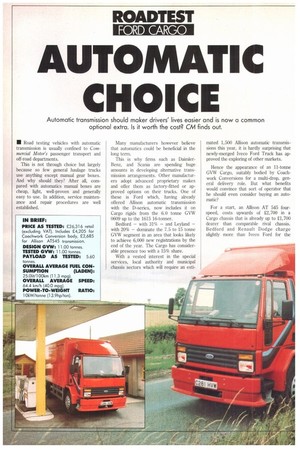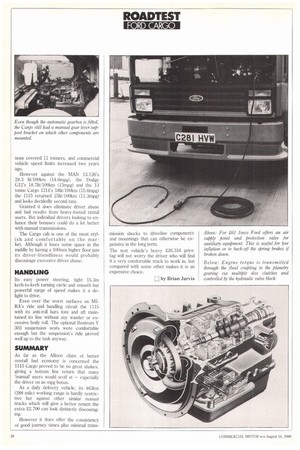AUTOMATIC CHOICE
Page 26

Page 27

Page 29

Page 30

If you've noticed an error in this article please click here to report it so we can fix it.
Automatic transmission should maker drivers' lives easier and is now a common optional extra. Is it worth the cost? CM finds out.
• Road testing vehicles with automatic transmission is usually confined to Commercial Motor's passenger transport and off-road departments.
This is not through choice but largely because so few general haulage trucks use anything except manual gear boxes. And why should they? After all, compared with automatics manual boxes are cheap, light, well-proven and generally easy to use. In addition, service maintenance and repair procedures are well established. Many manufacturers however believe that automatics could be beneficial in the long term.
This is why firms such as DaimlerBenz, and Scania are spending huge amounts in developing alternative transmission arrangements. Other manufacturers adopt advanced proprietary makes and offer them as factory-fitted or approved options on their trucks. One of these is Ford which, having already offered Allison automatic transmission with the D-series, now includes it on Cargo rigids from the 6.0 tonne GVW 0609 up to the 1615 16-tonner.
Bedford — with 31% — and Leyland — with 20% — dominate the 7.5 to 15 tonne GVW segment in an area that looks likely to achieve 6,000 new registrations by the end of the year. The Cargo has considerable presence too with a 15% share.
With a vested interest in the special services, local authority and municipal chassis sectors which will require an esti
mated 1,500 Allison automatic transmissions this year, it is hardly surprising that newly-merged Iveco Ford Truck has approved the exploring of other markets.
Hence the appearance of an 11-tonne GVW Cargo, suitably bodied by Coachwork Conversions for a multi-drop, general delivery role. But what benefits would convince that sort of operator that he should even consider buying an automatic?
For a start, an Allison AT 545 fourspeed, costs upwards of £2,700 in a Cargo chassis that is already up to £1,700 dearer than comparable rival chassis. Bedford and Renault Dodge charge slightly more than Iveco Ford for the AT545 but their chassis are cheaper.
Leyland also offers the option which is more of a factory-approved conversion for pretty much the same price, but its 11.14 truck cost more than £1,000 less than the Cargo. Volvo, with a growing interest in the municipal and special services market, is offering an FL6 12 tonner at £17,750 with an AT545 option costing 23,000.
Although Mercedes-Benz does not offer an automatic option in the UK, its 1114 is the least expensive of the 11tonners at £16,390.
According to Detroit Diesel Allison, a division of General Motors which markets automatics throughout the world, automatics have four main attractions. Reduced operating costs and improved fuel economy will interest the accountants who seem to have the final say in vehicle purchasing these days.
The other advantages, increased vehicle productivity and driveability, are equally important to operators.
So when Iveco Ford offered an 1115 Cargo automatic to CM for road test, we were naturally keen to see how these claims stood up to an operational trial on our distribution route.
Our previous road tests (all with manual gearboxes) have been at the 10 or 12 tonne marks. Even so, comparisons with earlier results around our longestablished Welsh route would also prove interesting.
DRIVELINE
The test vehicle, a 1115 Cargo on a 4.25m wheelbase, was powered by a 110kW 6.01itre turbocharged Dover diesel driving through a IC 270 multi-phase torque convertor to the Allison AT 545 fourspeed automatic transmission.
This is the smaller of three series available in UK and rated for engines with outputs of up to 175kW. It is best suited, says DDA, for city delivery, rental fleet and farm trucks. Airlines such as British Airways use them on airport duties.
With the Ford 16A/195 rear axle and 4.88:1 final drive ratio the Cargo is capable of about 100kinili (62 mph) which it
achieved during formal track testing at the Motor Industry Research Association proving grounds.
The vehicle, supplied by Ford of Europe, was one intended for demonstration abroad and accordingly came in left hand drive form.
That apart, it is identical to a UK-spec Cargo 1115 but had many non-standard extras. The most important of these were the under-bumper air darn and roofmounted deflector. A rear anti-roll bar supplements the one at the front but its importance really depends on the use to which the truck is to be put.
The one item missing was the third (clutch) pedal. Once accustomed to the extra floor space and easier driving characteristics it seems a sacrifice worth making.
11 PERFORMANCE
Driving with an Allison is very much footto-the-floor work which allows the unit to transmit the drive smoothly, changing gears automatically, whatever the vehicle speed or road conditions.
For most of the time, gear changes whether up or down, are barely audible and could only be detected by watching the flicker of the rev counter needle. The gear lever with its locking catch has six positions for the four-speed box: neutral for park or starting, R for reverse, D for drive (in all four gears) and 3rd, 2nd and 1st gear limitation.
In drive the vehicle moves silkily through the gears with the accelerator fully depressed. It is possible to change gears earlier as with a car by easing off the throttle but it is so quiet that it is difficult to detect the change, unless the rev counter is watched closely. Once a set speed has been attained the vehicle over-runs the transmission and drive becomes disconnected, giving a free-wheel effect. For controlled movement through busy streets the lever can be eased back a gear or two to limit its speed.
If extra braking is needed under difficult downhill conditions, moving the gear lever back to the 3rd slot raises the engine speed and although not very fuel efficient, does bring about a form of geared braking. If necessary this effect can be increased by selecting the next lower gear.
There is no danger from mistakenly selecting reverse as it will only engage when the truck has almost stopped. There is no park position however, so the selector is left in N (neutral) with the park brake off the vehicle will roll.
Getting used to the foot-down principle and waiting for the drive to commence takes a while as does the over-run condition.
At first this is disconcerting and the natural instinct is to dab at the foot brakes.
At speeds of up to 48knvh (29mph) in towns this brings a sharp response whereas at 64kmili (39mph) and upwards the floating feeling increases, especially on long bends or roundabouts. When slowing the vehicle at these speeds the brake pedal felt a bit ponderous until extra pressure was applied, but was still effective.
Acceleration was deceptively quick and proved considerably sharper in all departments than the early 4.25m w/b 13 tonne Cargo 1314, tested five years ago with the same engine but with a Ford eightspeed range-change box and 4:1 diff.
The 1115's journey times were equally remarkable with a slightly slower 52.9km/h (32.6mph) time on the inter-urban delivery route than the Volvo FL6 at 16 tonnes GVW, but with an equally quick 54 minutes over the M4 motorway section from Membury to Aust.
That was four minutes faster than the 1319 Cargo and one minute sharper than the flat-bodied Renault Dodge G12 (CM, April 12, 1984) with its 111kW turbocharged 16,354.4. The 1115 also matched the time of the nimble MAN 10.136 10tonner (CM, September 17, 1983). Any doubts about its acceleration were scotched by its hill climb times. It is quicker than all those mentioned and surprisingly only a few seconds slower than the Cargo 0811 7.5-tonner tested 18 months ago.
On Wantage Hill first gear was needed several times but there was no hint of any shock loading, gear clash or the slowing usually associated with manual gearboxes.
There was, however, a noisy grunt each time first gear went in and this also happened on roundabouts during sudden acceleration from overrun.
On long downhill runs where an exhaust brake becomes useful, the Cargo 1115 has to rely on its footbrakes which are quite adequate. Because of its fluid coupling an exhaust brake is not possible but DDA's mid-range gearbox has a lock-up facility on 3rd and 4th ratio as well as hydrodynamic output retarder if required.
At £4,671 for the MT643 and another £2,250 for the retarder they are not cheap.
Throughout the test the engine temperature stayed fairly constant at around 50-50°C, probably due to its fixed fan. Even on Wantage Hill the needle barely moved.
Its consistent performance suggests that it will comfortably absorb the sort of driver abuse usually meted out to rental vehicles.
FUEL ECONOMY
It is not possible to make a direct comparison with previous road tests because
none covered 11 tonners, and commercial vehicle speed limits increased two years ago.
However against the MAN 13.136's 19.3 lit/100km (14.6mpg), the Dodge G12's 18.71it/100km (15mpg) and the 13 tonne Cargo 1314's 18lit/100km (15.6mpg) the 1115 returned 251it/100km (11.3mpg) and looks decidedly second rate.
Granted it does eliminate driver abuse and bad results from heavy-footed rental users. But individual drivers looking to enhance their bonuses could do a lot better with manual transmissions.
The Cargo cab is one of the most stylish and comfortable on the market. Although it loses some space in the middle by having a 100mm higher floor pan its driver-friendliness would probably discourage excessive driver abuse.
HANDLING
Its easy power steering, tight 15.3m kerb-to-kerb turning circle and smooth but powerful surge of speed makes it a delight to drive.
Even over the worst surfaces on MIRA's ride and handling circuit the 1115 with its anti-roll bars fore and aft maintained its line without any wander or excessive body roll. The optional Bostrom V 303 suspension seats were comfortable enough but the suspension's ride proved well up to the task anyway.
SUMMARY
As far as the Allison claim of better overall fuel economy is concerned the 1115 Cargo proved to be no great shakes, giving a bottom line return that many 'manual' users would scoff at — especially the driver on an mpg bonus.
As a daily delivery vehicle, its 463km (288 mile) working range is hardly restrictive but against other similar manual trucks which will give a better return the extra 22.700 can look distinctly discouraging.
However it does offer the consistency of good journey times plus minimal trans mission shocks to driveline components and mountings that can otherwise be expensive in the long term.
The test vehicle's heavy £26,316 price tag will not worry the driver who will find it a very comfortable truck to work in, but compared with some other makes it is an expensive choice.
[I] by Brian Jarvis




































































